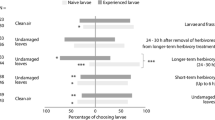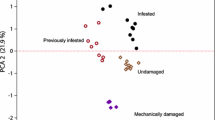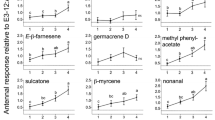Abstract
Many herbivorous insects induce preferences for host plants. Recent work in Manduca sexta indicates that induced preferences are mediated by a “tuning” of the peripheral taste system to chemicals within host plant foliage. We tested this hypothesis by rearing caterpillars on artificial diet or potato foliage, and then examining olfactory- and taste-mediated responses to potato foliage extract. First, we confirmed earlier reports that consumption of potato foliage tunes the peripheral taste system by reducing responsiveness to glucose and increasing responsiveness to foliage extract. Second, we offered caterpillars a choice between disks treated with foliage extract (experimental) or solvent alone (control). The foliage-reared caterpillars approached and consumed the experimental disks disproportionately, whereas the diet-reared caterpillars approached and consumed both disks indiscriminately. This indicated that induced preferences involve olfaction and taste. Third, we ran choice tests with foliage-reared caterpillars deprived of either olfactory or gustatory input. Caterpillars lacking olfactory input approached both disks indiscriminately, but fed selectively on experimental disks. In contrast, caterpillars lacking gustatory input approached experimental disks selectively, but fed indiscriminately on both types of disk. We conclude that even though olfaction helps caterpillars locate potato foliage, it is the “tuned” gustatory response that ultimately mediates the induced preference.




Similar content being viewed by others
References
Appel HM, Martin M (1992) Significance of metabolic load in the evolution of host specificity of Manduca sexta. Ecology 73:216–228
Bell RA, Joachim FA (1976) Techniques for rearing laboratory colonies of tobacco hornworms and pink bollworms. Ann Entomol Soc Am 69:365–373
Bernays EA, Weiss MR (1996) Induced food preferences in caterpillars: the need to identify mechanisms. Entomol Exp Appl 78:1–8
Bernays EA, Glendinning JI, Chapman RF (1998) Plant acids modulate chemosensory responses in Manduca sexta larvae. Physiol Entomol 23:193–201
Carlsson MA, Anderson P, Hartlief E, Hansson BS (1999) Experience-dependent modification of orientational response to olfactory cues in larvae of Spodoptera littoralis. J Chem Ecol 25:2445–2454
de Boer G (1991) Effect of diet experience on the ability of different larval chemosensory organs to mediate food discrimination by the tobacco hornworm, Manduca sexta. J Insect Physiol 37:763–769
de Boer G (1993) Plasticity in food preference and diet-induced differential weighting of chemosensory information in larval Manduca sexta. J Insect Physiol 39:17–24
de Boer G (2006) The role of the antennae and maxillary palps in mediating food preference by larvae of the tobacco hornworm, Manduca sexta. Entomol Exp Appl 119:29–38
de Boer G, Hanson FE (1984) Food plant selection and induction of feeding preferences among host and non-host plants in larvae of the tobacco hornworm, Manduca sexta. Entomol Exp Appl 35:177–194
de Boer G, Hanson FE (1987) Differentiation of roles of chemosensory organs in food discrimination among host and non-host plants by larvae of the tobacco hornworm, Manduca sexta. Physiol Entomol 12:387–398
del Campo ML, Miles CI (2003) Chemosensory tuning to a host recognition cue in the facultative specialist larvae of the moth Manduca sexta. J Exp Biol 206:3979–3990
del Campo ML, Renwick JAA (1999) Dependence on host constituents controlling food acceptance by Manduca sexta larvae. Entomol Exp Appl 93:209–215
del Campo ML, Renwick JAA (2000) Induction of host specificity in larvae of Manduca sexta: chemical dependence controlling host recognition and developmental rate. Chemoecol 10:115–121
del Campo ML, Miles CI, Schroeder FC, Muellerk C, Booker R, Renwick JA (2001) Host recognition by the tobacco hornworm is mediated by a host plant compound. Nature 411:186–189
Dethier VG, Crnjar RM (1982) Candidate codes in the gustatory system of caterpillars. J Gen Physiol 79:549–569
Gaertner LS, Murray CL, Morris CE (1998) Transepithelial transport of nicotine and vinblastine in isolated malpighian tubules of the tobacco hornworm (Manduca sexta) suggests a P-glycoprotein-like mechanism. J Exp Biol 201:2637–2645
Glendinning JI, Valcic S, Timmermann BN (1998) Maxillary palps can mediate taste rejection of plant allelochemicals by caterpillars. J Comp Physiol A 183:35–44
Glendinning JI, Tarre M, Asaoka K (1999) Contribution of different bitter-sensitive taste cells to feeding inhibition in a caterpillar (Manduca sexta). Behav Neuorsci 113:840–854
Glendinning JI, Nelson N, Bernays EA (2000) How do inositol and glucose modulate feeding in Manduca sexta caterpillars? J Exp Biol 203:1299–1315
Glendinning JI, Brown H, Capoor M, Davis A, Gbedemah A, Long E (2001) A peripheral mechanism for behavioral adaptation to specific “bitter” taste stimuli in an insect. J Neurosci 21:3688–3696
Glendinning JI, Davis A, Ramaswamy S (2002) Contribution of different taste cells and signaling pathways to the discrimination of “bitter” taste stimuli by an insect. J Neurosci 22:7281–7287
Glendinning JI, Jerud A, Weinberg A (2007) The hungry caterpillar: an analysis of how carbohydrates stimulate feeding in Manduca sexta. J Exp Biol 210:3054–3067
Gothilf S, Hanson FE (1994) A technique for electrophysiologically recording from chemosensory organs of intact caterpillars. Entomol Exp Appl 72:304–310
Hansberry R, Middlekauff WW (1940) Toxicity of nicotine administered internally to several species of insect. J Econ Entomol 33:511–517
Hanson FE (1976) Comparative studies on induction of food choice preferences in Lepidopterous larvae. Symp Biol Hung 16:71–77
Hanson FE, Dethier VG (1973) Role of gustation and olfaction in food plant discrimination in the tobacco hornworm, Manduca sexta. J Insect Physiol 19:1019–1034
Itagaki H, Hildebrand JG (1990) Olfactory interneurons in the brain of the larval sphinx moth Manduca sexta. J Comp Physiol A 167:309–320
Jermy T (1987) The role of experience in the host selection of phytophagous insects. In: Chapman RF, Bernays EA, Stoffolano JG Jr (eds) Perspectives in chemoreception and behavior. Springer, New York, pp 143–157
Jermy T, Hanson FE, Dethier VG (1968) Induction of specific food preference in Lepidopterous larvae. Entomol Exp Appl 11:211–230
Kent KS, Hildebrand JG (1987) Cephalic sensory pathways in the central nervous system of larval Manduca sexta (Lepidoptera: Sphingidae). Philos Trans R Soc Lond B Biol Sci 315:1–36
Ma W-C (1972) Dynamics of feeding responses in Pieris brassicae Linn as a function of chemosensory input: a behavioral and electrophysiological study. Meded Laudbouwhogeschool Wageningen 72–11:1–162
Maddrell SP, Gardiner BOC (1976) Excretion of alkaloids by Malpighian tubulues of insects. J Exp Biol 64:267–281
Marion-Poll F, Van der Pers J (1996) Un-filtered recordings from insect taste sensilla. Entomol Exp Appl 80:113–115
McFadden MW (1968) Observations on feeding and movement of tobacco hornworm larvae. J Econ Entomol 61:352–356
Murray CL, Quaglia M, Arnanson JT, Morris CE (1994) A putative nicotine pump at the metabolic blood-brain barrier of the tobacco hornworm. J Neurobiol 25:23–34
Renwick JAA, Huang XP (1995) Rejection of host plant by larvae of cabbage butterfly: diet-dependent sensitivity to an anti-feedant. J Chem Ecol 21:465–475
Roessingh P, Xu S, Menken SBJ (2007) Olfactory receptors on the maxillary palps of small ermine moth larvae: evolutionary history of benzaldehyde sensitivity. J Comp Physiol A 193:635–647
Saxena KN, Schoonhoven LM (1978) Induction of orientational and feeding preferences in Manduca sexta larvae for an artificial diet containing citral. Entomol Exp Appl 23:72–78
Saxena KN, Schoonhoven LM (1982) Induction of orientational and feeding preferences in Manduca sexta larvae for different food sources. Entomol Exp Appl 32:173–180
Schoonhoven LM (1967) Loss of hostplant specificity by Manduca sexta after rearing on an artificial diet. Entomol Exp Appl 10:270–272
Schoonhoven LM (1972) Plant recognition by lepidopterous larvae. In: van Emden HF (ed) Insect/plant relationships. Blackwell, Oxford, pp 87–99
Schoonhoven LM, Dethier VG (1966) Sensory aspects of host-plant discrimination by lepidopterous larvae. Arch Neerland Zool 16:497–530
Schoonhoven LM, van Loon JJA (2002) An inventory of taste in caterpillars: each species is its own key. Acta Zool Acad Sci Hung 48(Suppl 1):215–263
Smid HM, Wang G, Bukovinszky T, Steidle JLM, Bleeker MAK, van Loon JJA, Vet LEM (2007) Species-specific acquisition and consolidation of long-term memory in parasitic wasps. Proc R Soc Lond B 274:1539–1546
Snyder MS, Glendinning JI (1996) Causal connection between detoxification enzyme activity and consumption of a toxic plant compound. J Comp Physiol A 179:255–261
Snyder MJ, Walding JK, Feyereisen R (1994) Metabolic fate of the allelochemical nicotine in the tobacco hornworm Manduca sexta. Insect Biochem Molec Biol 24:837–846
Städler E, Hanson FE (1975) Olfactory capabilities of the “gustatory” chemoreceptors of the tobacco hornworm. J Comp Physiol 104:97–102
Städler E, Hanson FE (1978) Food discrimination and induction of preference for artificial diets in the tobacco hornworm, Manduca sexta. Physiol Entomol 3:121–133
Szentesi A, Jermy T (1990) The role of experience in host plant choice by phytophagous insects. In: Bernays EA (ed) Insect-plant interactions. CRC Press, Boca Raton, pp 39–74
Ting A, Ma X, Hanson FE (2002) Induction of feeding preference in larvae of the patch butterfly, Chlosyne lacinia. Acta Zool Acad Sci Hung 48(Suppl 1):281–295
Verhagen JV, Engelen L (2006) The neurocognitive bases of human multimodal food perception: sensory integration. Neurosci Biobehav Rev 30:613–650
Waldbauer GP, Fraenkel G (1961) Feeding on normally rejected plants by maxillectomized larvae of the tobacco hornworm, Protoparce sexta (Lepidoptera: Sphingidae). Ann Entomol Soc Am 54:477–485
Walters ET, Illich PA, Weeks JC, Lewin MR (2001) Defensive responses of larval Manduca sexta and their sensitization by noxious stimuli in the laboratory and field. J Exp Biol 204:457–469
Yamamoto RT (1974) Induction of hostplant specificity in the tobacco hornworm, Manduca sexta. J Insect Physiol 20:641–650
Yamamoto RT, Fraenkel G (1960) Assay of the principal gustatory stimulant for the tobacco hornworm, Protoparce sexta, from solanaceous plants. Ann Entomol Soc Am 53:499–503
Acknowledgments
We thank Alan Renwick for help making the potato leaf extract, and Martha Weiss for editorial comments. This project was supported in part by research grant number 5 R29 DC 02416 from the National Institute on Deafness and Other Communication Disorders, National Institutes of Health (to JIG). The experiments comply with the National Institutes of Health “Principles of Animal Care,” publication No. 86-23, revised 1985.
Author information
Authors and Affiliations
Corresponding author
Rights and permissions
About this article
Cite this article
Glendinning, J.I., Foley, C., Loncar, I. et al. Induced preference for host plant chemicals in the tobacco hornworm: contribution of olfaction and taste. J Comp Physiol A 195, 591–601 (2009). https://doi.org/10.1007/s00359-009-0434-7
Received:
Revised:
Accepted:
Published:
Issue Date:
DOI: https://doi.org/10.1007/s00359-009-0434-7




